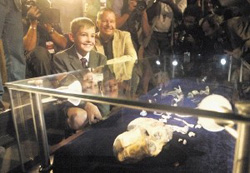This Day in History: April 8, 2010
Additional Date: April 8, 2010
Professor Lee Berger and his son Matthew Berger (9 years) stumbled across a new species of hominid, Australopithecus sediba, estimated to be 2 million years while looking for fossils at the Cradle of Humankind. The find was announced on 8 April 2010 at Maropeng, at a function attended by Deputy President Kgalema Motlanthe and other Government Ministers. Professor Berger, a renowned paleoanthropologist (a scientist who studies human fossils, and the evolution of modern man) from the University of Witwatersrand and his son discovered the fossils at the Malapa Cave site in August 2008. The find may tell us about the where and how of human evolution. The fossils of an adult female and a juvenile are a completely new species of hominids or human like ancestral creatures unveiled for the first time. The find has been hailed by academics and scientists around the world. Besides the two hominid fossils, the fossil remains of an infant, in a rock half the size of a rugby ball was discovered on 17 May 2009. The juvenile, a young male is believed to be about ten years old when he died. The fossils of the infant, about 12 - 18 months old when it died was discovered by Dr Brian Kuhn, a researcher based at the Institute for Human Evolution at the University of Witwatersrand, after cleaning the bones. Dr Kuhn believed that the female fossil, shown to the world, for the first time on 8 April 2010, was the infant's mother because of the close proximity in which it was found. The woman's bones indicate that she was around 35 years old. Her skull has not yet been found. Prof. Berger believes that it is embedded in a chunk of rock found at the site. The infant hominid's ulna is less than 1cm wide and about 1.5cm long while the humerus is 2cm wide. Prof. Berger and his team believe that the adult female, juvenile and the infant fell into a cave about two million years ago. A large rainstorm probably swept the remains into an underground pool or lake, where the bones solidified. The new species, according to Prof. Berger, had long arms such as an ape's, short powerful hands and a very advanced pelvic hipbone, as well as long legs capable of striding and possibly running like a human. Prof. Berger took the juvenile's fossils to the European Synchrotron Radiation Facility (ESRF) in France to test them using highly sophisticated equipment. Here the skull was scanned over four days. The scan has created a permanent record of the skull at the highest resolution.
